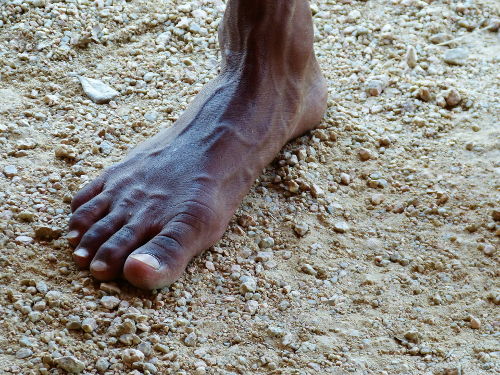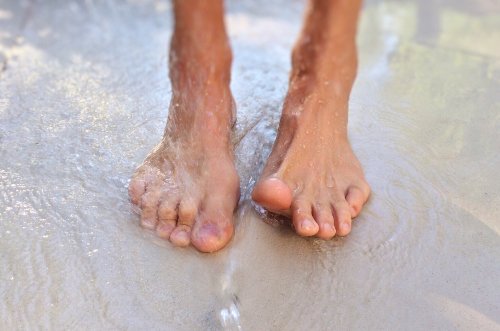How to start practicing barefoot walking/running and what to think about when buying a pair of minimalistic shoes
In this article, I will give tips on how to start practicing barefoot walking and running if you’ve never done it and what to think about when you buy your first pair of minimalistic shoes.
This is the last article in my series about barefoot walking and running, my earlier ones covered
Part 1 - My experience with barefoot walking and how I healed my knee
Part 2 - Common myths about barefoot walking and running
Part 3 - How barefoot walking and running can help us relax and teach us body awareness
I recommend reading part 3 together with this article because they overlap each other and I will refer to it throughout this text.
So let’s get started :)
Learn how to walk and run barefoot
Walking barefoot
Pure barefoot, without shoes, can be done whenever you have time. It doesn’t need to be pretentious, just take your shoes off when you take a walk and whenever you have enough or lose the concentration (this refers to the relaxation technique I wrote about in my third article), just put the shoes back on again. I’ve found that in the beginning the feet will hurt after awhile, even if I manage to be relaxed. They just need to become used to it, but it happens fairly quickly if you practice often and remember to be relaxed while walking.
The easiest ground to start with is probably a hard surface, like asphalt, although I’ve mostly practiced on dirt roads full of pebbles because that’s what I’ve had around. Grass is not ideal because it’s so soft you never get the feedback if you are walking or using your body wrong. You can be a master walker on grass just to realize you still have some things to learn the moment you come out on normal roads.

When you start practicing it’s important to treat it as a walking meditation, not an exercise to get fit. With time you’ll be able to walk faster and maybe even make hikes without shoes, but in the beginning just be gentle with yourself. I also start very slowly after the winter break and the first day I only manage maybe a couple of 100 meters/yards and then I put my shoes on again. The next day I do it again and within a couple of days, I can walk for a kilometer or two (0.5-1 mile) without shoes. It took me longer to reach this point when I just started out, so for you it might take a couple of weeks to be able to walk longer distances but you’ll get there if you just keep practicing and being relaxed while doing it. There’s no need to rush, the goal is to be able to walk barefoot, not to do it as fast as possible.
Running
If you want to learn to run without shoes I advice starting out walking first. Once you’ve learned the relaxation technique/awareness and can use it while walking, slowly start to run for shorter distances (sometimes this means just a couple of 100 meters/yards). With time you’ll be able to build up to longer runs but don’t expect to make the switch within a week or two, patience is the keyword. Remember, being frustrated means tensing yourself which is counterproductive when you learn to walk or run barefoot.
A way to handle these situations is to put a long-term goal and make the agreement with yourself that you cannot change it until the time has passed. For example: I say that I will follow all the “rules” set out (do the relaxation techniques, not stress and not be frustrated) for 6 months, and if I don’t have any progress after that time I’m allowed to be frustrated and angry. The trick is to put such a long testing-time that when those six months have passed you will have had some progress and maybe even reached your goal and it won’t be an issue any longer. But the mind is put to ease because it knows that at some point it will be allowed to vent all its frustrations, just not yet.
Important last thing
One last, very important thing when learning barefoot walking or running: Always have your shoes with you in case you need them. It’s horrible to be on a long walk or run and realising half-way through that I need my shoes because my feet are sore, and not having them with me. Believe me, I’ve tried it. It’s also important because you might find yourself on a stretch that would be outright dangerous to walk/ run barefoot on, for example, if there is broken glass on the ground.
Minimalistic shoes
Maybe you’ve practiced barefoot walking or running for a while and would like to extend it to going in town or when you’re working. Or you want to jump on the non-padded-shoes-train straight away and get yourself a pair of minimalistic shoes. You can read about the difference between pure barefoot and minimalistic shoes in my article here.
So, how to choose a pair of minimalistic shoes? And how to start using them? There are a couple of things to consider.
Get a good brand. Not all companies advertising barefoot shoes are actually good so make some research before. The shoes need to have a wide toe box, non-elevated steps, not being padded or have any support system and have a thin and flexible sole to allow the feet the move the most naturally. There are both covered shoes and sandals out there so you can get it to fit all seasons.
Once you have your shoes, know that you might need to get use to them. You will start to use muscles that you’ve never used before (or at least not since you were a kid) so you might get sore or poor body use can show up when the shoe padding no longer takes the biggest hit so you might get blisters etc. My advice:
- Be aware of it and don’t think that the shoes are wrong. They only show you what’s been wrong the whole time.
- Don’t overdo things, this is not a race to become barefoot as fast as you can
- Read about other people’s journey on the internet, there is a lot of material out there to help.
- And most important: try to change what’s wrong! Experiment with different ways of walking or running, feel how it feels in the body when you do that, did it get better or worse? If you’ve located an area in the body that you feel is being used wrong, either focus on it in your practice or go see a physical therapist of some sort to work on it.
Conclusion
Barefoot walking and running is a journey, you’ll keep discovering things as you go and you’ll learn more about your body and what areas need attention. My best advice is to have patience, don’t stress cause that will great tension in you body which is, as I’ve mentioned, counterproductive to your progress. Most of all: have fun! The feeling when you manage to walk or run longer distances and being in peace with you body while doing it is amazing and one worth working for!
If you have any questions or comments, please ask and I’ll do my best to answer them. Upvote if you liked this article and follow me for more good articles!
